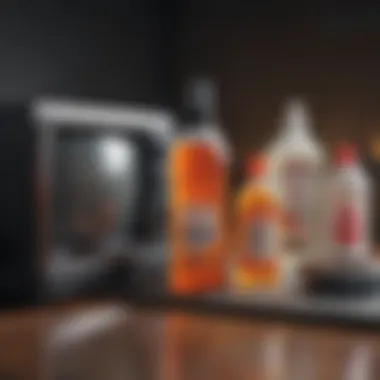Is Glass Cleaner Safe for Your TV Screen?


Intro
In today's digital world, televisions are central to our household experience. They occupy a prominent space in our living rooms and play a role in our leisure time. Thus, keeping them clean is essential. Yet, a common question arises: can you clean a TV with traditional glass cleaner? This query is vital for maintaining the longevity and visual clarity of screens.
Glass cleaners, like Windex, are designed for shiny surfaces. The chemicals within these products can be harmful to TV screens, especially LCD, LED, and OLED types. Understanding the composition of these cleaners and their potential effects on televisions is necessary. This article delves deeper into safe cleaning practices for various TV models while also highlighting what to avoid.
We will cover the risks and benefits of using different cleaning solutions and techniques in this guide. A well-maintained television not only enhances your viewing experience but also prolongs the device's life. As you read on, you will learn what products are safe to use and how to care for your screen appropriately.
Understanding TV Screens
Understanding the different types of TV screens is crucial for anyone wanting to maintain their device properly. Each screen technology has its unique characteristics and cleaning needs, which impacts how they should be treated. Ignoring these differences can lead to unintentional damage, causing issues ranging from image quality degradation to complete screen failure. Knowing these details ensures optimal care and extends the lifespan of the television.
Types of TV Screens
LED Screens
LED screens utilize light-emitting diodes for backlighting. This technology allows for bright, vibrant colors and excellent energy efficiency. One key characteristic of LED screens is their ability to generate higher brightness levels, which enhances picture quality in well-lit environments. However, they can be sensitive to certain cleaning products. The relative popularity of LED screens stems from their affordability and good picture quality. It is essential to avoid harsh chemicals that could harm the delicate surface, ensuring cleaning methods align with their specifications.
OLED Screens
OLED, or organic light-emitting diode screens, represent a significant advancement in display technology. They provide remarkable contrast ratios and color accuracy because each pixel emits its own light. This unique feature allows for true blacks and an immersive viewing experience. The popularity of OLED screens comes from their aesthetic performance. However, they can be prone to screen burn-in if static images are displayed for prolonged periods. Due to their sensitivity, caution is needed when selecting cleaning products.
Screens
LCD screens employ liquid crystal displays for image production. Known for their thin profiles and relatively low production costs, LCD televisions remain a common choice in many households. The key advantage lies in their sharp images and lower power consumption compared to older technologies. However, they may have issues with viewing angles and color reproduction when compared to OLED displays. Take care when cleaning LCD screens, as improper methods can lead to surface scratches or damage to internal components.
Screen Coatings and Treatments
Understanding screen coatings and treatments is vital. These elements can enhance the viewing experience but may also require specific care.
Anti-reflective Coating
Anti-reflective coatings are applied to screens to reduce glare and reflections. This feature significantly improves the viewing experience, especially in bright environments. These coatings are popular because they lead to more comfortable viewing and clearer images. However, care must be taken when cleaning, as certain chemicals can degrade these coatings and diminish their effectiveness over time, potentially leading to a diminishing viewing experience.
Touchscreen Technology
Touchscreen technology is becoming increasingly prevalent in televisions. This feature enhances interactivity and usability, making it easier to navigate menus and content. The key characteristic of touchscreen displays is their sensitivity to touch, offering a user-friendly interface. However, this makes them more susceptible to fingerprints and smudges. Cleaning must be done with appropriate materials to avoid scratches or any damage to the touch-sensitive surface.
Composition of Glass Cleaners
Understanding the composition of glass cleaners is crucial for determining their suitability for cleaning televisions. Glass cleaners typically contain a mix of chemicals designed to clean and shine surfaces. Knowing these ingredients helps users make informed choices about what to use on their TVs. Some components may pose risks to screen integrity, while others can enhance cleaning efficiency without causing damage.
Common Ingredients
Ammonia
Ammonia is a common ingredient in many glass cleaners. It is known for its strong cleaning power, effectively breaking down grime and dirt. Its key characteristic is its ability to evaporate quickly, leaving surfaces streak-free. This makes it a popular choice for cleaning glass and shiny surfaces. However, while ammonia is effective, it can also be harsh on certain screen types. This poses a risk for screens that have special coatings. Over time, ammonia can weaken or wear away these coatings.
Alcohol


Alcohol is another prevalent ingredient in glass cleaners. It serves as a disinfectant and enhances the cleaning process by cutting through oils and residues. One of its unique features is its rapid evaporation rate, which helps avoid water damage on sensitive surfaces. Although alcohol is generally safe for many surfaces, it can sometimes cause issues with specific screen coatings. This can lead to a dull appearance if used incorrectly.
Surfactants
Surfactants are compounds that help to lower the surface tension of liquids, making it easier for the cleaning solution to spread and penetrate dirt. This feature enhances the overall cleaning effectiveness of glass cleaners. The presence of surfactants can improve the cleaner’s performance without relying solely on harsh chemicals. However, not all surfactants are created equal. Some may leave residues that can be problematic for TVs. Understanding the type of surfactant used can help users avoid unwanted effects.
Potential Risks
Screen Damage
Screen damage is a significant concern when using glass cleaners. Many televisions employ delicate technologies such as OLED and LCD screens, which can be impacted by certain cleaning products. Using a cleaner containing harsh chemicals can cause irreversible damage. Therefore, screen damage is a key point when considering any cleaning product, particularly glass cleaners not designed for electronic devices. Affected screens may display discoloration, fading, or even permanent marking after improper cleaning.
Coating Degradation
Coating degradation relates to the deterioration of protective films on screens, which can result from the wrong cleaning materials. Many modern TVs have specialized coatings that enhance viewing experience, such as anti-reflective surfaces. The degradation of these coatings reduces their effectiveness. It's important to recognize how cleaners can interact with these coatings and the potential long-term impact on a TV's performance.
To maintain a TV's longevity, consider carefully the products used for cleaning.
Evaluating the Safety of Glass Cleaners
Understanding whether glass cleaners are safe for TVs is crucial for maintaining the integrity of these devices. Many people still use regular glass cleaning products to clear their screens, but the potential risks can outweigh any perceived benefits. This section will dive into what manufacturers recommend and sift through user experiences to clarify the truth about cleaning your television with glass cleaner.
Manufacturer Guidelines
Recommendations from Brands
Most leading TV manufacturers are clear about their cleaning recommendations. For instance, Samsung, LG, and Sony advocate for the use of soft microfiber cloths and distilled water. They emphasize that using glass cleaners containing ammonia or alcohol can lead to irreversible damage to the screen. This guideline is based on the common characteristics of glass cleaners that can strip protective coatings, which are found on modern screens.
The unique feature of these recommendations is their focus on preserving the screen's anti-reflective or oleophobic layers. By using only a gentle cloth and distilled water, users can effectively remove smudges while maintaining their TV's longevity.
Common Myths
There are several misconceptions surrounding the use of glass cleaners on TVs. One such myth is that any product designed for glass can be used safely on any screen. This is misleading and can harm the television. Users may believe that a quick wipe with a glass cleaner is all that is needed for a spotless screen. However, this can lead to significant damage over time, particularly if the cleaner contains harsh chemicals.
The idea that all glass cleaners are created equally is a critical point of misunderstanding. Many products include additives that make them unsuitable for electronics, particularly those with special coatings on the screens. Recognizing this allows users to avoid detrimental choices.
User Experiences
Success Stories
There are users who have shared positive experiences by adhering closely to manufacturer guidelines. Regularly cleaning their TVs with a microfiber cloth and distilled water has proven effective in maintaining screen clarity and functionality. Many report that they have not encountered any issues such as streaks or discoloration by following these simple methods. This reinforces the notion that proper cleaning techniques enhance the overall viewing experience.
Warnings from Users
Conversely, numerous warnings from users highlight the dangers of using traditional glass cleaners. Many have reported screen damage ranging from ghosting effects to complete failure of the display, often attributed to improper cleaning techniques. Users point out that caution is essential, and they advise against using any products that are not specifically recommended for TVs. This caution is a valuable lesson about the repercussions of ignoring manufacturer advice.
It is crucial to follow recommended cleaning methods to preserve the quality and longevity of your TV.
In summary, evaluating the safety of glass cleaners involves understanding the implications of their use on modern screens. Both manufacturer guidelines and user experiences provide valuable insight that can aid in making informed decisions while cleaning televisions. By approaching the subject with care, users can maintain their devices without the risk of damage.


Alternative Cleaning Methods for TVs
Finding the right way to clean your TV is crucial. As stated previously, glass cleaner is not always suitable for screens. Hence, alternative methods provide safer options for keeping your television clean. These methods can prevent potential damage while maintaining optimal display quality. Using proper techniques and tools ensures longevity of your TV screen, making it vital for any avid TV watcher.
Microfiber Cloths
How to Use
Using microfiber cloths is an effective approach to cleaning your TV. To start, you must ensure that the cloth is dry. Simply wipe the screen in gentle circular motions. Avoid applying too much pressure; this can cause damage to the screen over time. It is advisable to clean the TV screen regularly, so dust does not accumulate. A microfiber cloth's unique ability to trap dust and dirt makes it popular for many household cleaning tasks.
Benefits of Microfiber
Microfiber has numerous benefits making it an exceptional cleaning tool. It does not scratch the screen, which is vital for preserving its integrity. The fine fibers can absorb more dirt and dust compared to traditional cloths. This material is also lint-free, allowing for a perfect finish after cleaning. Overall, microfiber is a practical choice for TV cleaning.
DIY Cleaning Solutions
Distilled Water
Distilled water is another safe option for cleaning TVs. Unlike tap water, distilled water does not have minerals that can lead to spots on the screen. To use it, mix distilled water with a bit of vinegar if needed. Gentle wiping with a damp cloth can remove fingerprints and smudges effectively. It stands out as a friendlier choice for the environment as well.
Vinegar Solutions
Vinegar solutions offer a natural method for cleaning. Mixing equal parts of water and vinegar creates a powerful yet safe cleaner. Use this solution cautiously with a soft cloth. Vinegar can cut through grime while leaving a streak-free finish. However, ensure that the solution is not too strong as it may impact certain screen coatings negatively.
In summary, using microfiber cloths or DIY cleaning solutions like distilled water and vinegar can greatly benefit the cleaning of your TV. These methods promote a safer approach that avoids risking damage often associated with harsher commercial cleaners.
Maintaining Your TV
Maintaining your television is crucial for ensuring its longevity and performance. Proper care can prevent common issues such as screen glare, image distortion, and unresponsive features. In the context of this article, maintaining your TV does not only relate to superficial cleanliness but also involves systematic care practices that support the screen's intrinsic technology. Failure to adhere to maintenance might lead to problems that worsen over time, diminishing your viewing experience.
Regular Maintenance Tips
Routine Cleaning Schedule
A routine cleaning schedule is essential for preserving the quality of your television. This practice involves dedicating specific times to clean the TV screen and surrounding areas. The key characteristic of a regular cleaning schedule is its consistency, which helps prevent the accumulation of dust and fingerprints. This is a beneficial choice because it makes the cleaning process less tiresome.
The unique feature of having this schedule is the peace of mind it provides; you can enjoy your TV without the distraction of smudged screens. On the flip side, if cleaning is neglected, stubborn marks can develop, making it harder to restore clarity later.
Proper Storage Guidelines
Proper storage guidelines play a significant role in maintaining your TV’s condition. When not in use, storing the TV in a suitable environment prevents damage from dust, moisture, and temperature fluctuations. The main feature of these guidelines is that they emphasize controlled conditions; for example, keeping the TV in a dry, dark place.
This is a popular choice for maintaining your television as it assures the least interference with its performance. However, it is also important to avoid areas with extreme temperature changes, as these can lead to internal damage over time.
Dealing with Stubborn Marks
Safe Removal Techniques
Safe removal techniques are vital when dealing with marks that resist cleaning efforts. Using appropriate techniques ensures that the screen remains undamaged while attempting to restore its clarity. The key characteristic here is the methodical approach, where you can identify the type of mark and apply the most suitable cleaning practice. This strategy is a beneficial choice because it minimizes the risk of using harmful substances.


The unique feature of safe removal techniques is their adaptability; for example, using a damp microfiber cloth can be adjusted based on the severity of the stain. Sometimes, however, these techniques may require repeated applications, which can be daunting.
Products to Avoid
Being aware of products to avoid is as critical as knowing what to use. Certain cleaning agents contain harsh chemicals that can irreparably damage your TV screen. The key characteristic of this knowledge is precaution; it helps consumers make informed decisions regarding their cleaning products. Avoiding these harmful products is beneficial since it prolongs your TV's lifespan without compromising screen quality.
The unique aspect of identifying these products is that many household cleaners, which seem harmless, often contain ammonia or other solvents that can dull the screen’s finish. Understanding what not to use can save consumers both time and money in the long run.
Environmental Considerations
Cleaning methods can significantly impact the health of our environment. In the context of cleaning televisions, choosing safer and eco-friendly options is crucial. Many conventional cleaners contain harsh chemicals which do not only affect the surfaces they clean but can also have broader implications on ecosystems. By examining environmentally friendly approaches, individuals can ensure they maintain their TVs without compromising their health and the environment.
Eco-friendly Cleaning Options
Natural Ingredients
Natural ingredients are derived from plant sources and are often perceived as safer alternatives to synthetic chemicals. Many people appreciate them because they reduce the risk of introducing harmful substances into homes. Natural ingredients like vinegar and baking soda have proven effective in cleaning various surfaces, including televisions.
One key characteristic of natural ingredients is their minimal environmental footprint. They are biodegradable and do not leave behind toxic residues. This makes them a popular choice for individuals looking for effective yet safe ways to maintain their electronics. However, there are some disadvantages. For instance, they might require more effort to clean compared to conventional products. Furthermore, some natural ingredients may not be as effective against stubborn stains, making users rely on more than one method.
Biodegradable Products
Biodegradable products break down into non-toxic components and are less harmful to the environment. They are specifically designed to minimize waste and offer an eco-friendly alternative to traditional cleaning solutions. The presence of biodegradable ingredients means they can safely decompose, returning to the environment without causing harm.
A significant advantage of biodegradable products is their ability to clean effectively without leaving harmful residues. This quality makes them attractive for those concerned about both health and environmental impacts. However, these products might come at a higher price point compared to their synthetic counterparts. Nonetheless, the benefits to well-being and sustainability often outweigh the costs for conscious consumers.
Impact of Chemical Cleaners
Effect on Indoor Air Quality
Chemical cleaners can release volatile organic compounds (VOCs) into the air. These compounds can deteriorate indoor air quality, leading to various health issues over time. Using glass cleaners with ammonia or alcohol may create an unhealthy environment, particularly in poorly ventilated areas. This impact on indoor air quality should be a point of concern for anyone maintaining their televisions using chemical-based cleaners.
One major reason to consider options that do not compromise indoor air quality is that poor air can affect long-term health. Individuals, especially those with respiratory issues, should prioritize non-toxic and natural cleaners. This decision can greatly enhance not only the overall health of occupants but also the maintenance habits around electronic devices.
Long-term Environmental Impact
The long-term environmental impact of using chemical cleaners extends far beyond immediate readability and effectiveness. Many chemical substances, when washed off, end up in water systems, risking contamination of water sources. Additionally, they can disrupt local ecosystems and harm wildlife, leading to a cascade of ecological consequences that can be significant and lasting.
A notable characteristic of this impact is the potential for accumulation of harmful chemicals in the environment. Over time, their presence can build up, leading to a more toxic ecosystem overall. Understanding these long-term effects encourages more thoughtful choices in cleaning methods. In this regard, focusing on sustainable practices will lead to healthier homes and a cleaner environment for future generations.
Finale
In this section, we will clarify the importance of understanding how to clean your TV screen appropriately. The topic of cleaning televisions is vital as it impacts both the performance and longevity of these devices. Different TV screens have unique needs. This has consequences for their maintenance. Hence, using the correct cleaning method ensures optimal viewing experience.
Summary of Key Points
- Glass Cleaners: Not all glass cleaners are safe for TVs. Some contain ingredients like ammonia and alcohol, which can damage the screen's coating.
- Manufacturer Guidelines: Always refer to the manufacturer's cleaning recommendations before proceeding.
- Cleaning Alternatives: Using microfiber cloths or homemade solutions is safer. They cause lesser risk to screen integrity.
- Environmental Impact: Consider using eco-friendly options. They are better for both health and planet.
Recommendations for Safe Cleaning
- Use Microfiber Cloths: These are the safest option. They do not scratch the screen.
- DIY Solutions: Prepare a gentle solution with distilled water or equal parts vinegar and water. Avoid harsh chemicals.
- Avoid Spray Directly on Screen: Instead, lightly dampen the cloth and then wipe the screen. This reduces risk of liquid seepage into the device.
- Regular Cleaning: Establish a routine to keep the screen clean. This helps prevent buildup of dust and dirt.
"Caring for your TV ensures its optimum functionality and longevity."
By following these guidelines, you will maintain your TV. Your investment will stand the test of time as a result.







